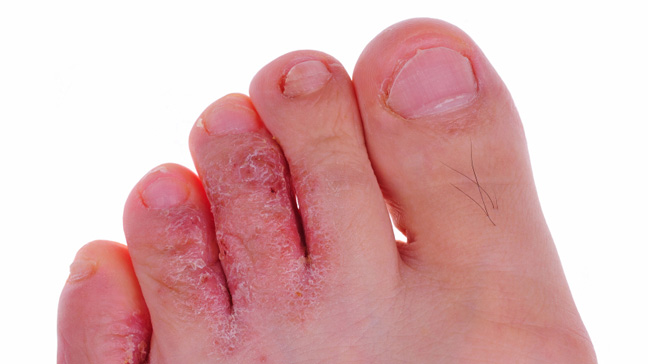Athlete's foot is a common infection caused by a fungus called "tinea pedis". Fungal germs live on your skin and don't usually cause any problem. But sometimes, these germs invade the skin and lead to infection. To thrive, the fungal germs select moist, warm, and airless areas of skin, such as between the toes. The irritating fungal infection doesn't only affect athletes. It can affect anyone walking barefoot on wet or damp floors in bathrooms, changing rooms or at the swimming pools.

What Are the Symptoms of Athlete's Foot?
The common symptoms include:
- Cracked, peeling skin between the toes
- Red and itchy skin
- Inflammation or stinging pain
- Blisters that get crusty or ulcers
- Thick, discolored toenails
Athlete's foot may also spread to the soles of the feet, groin, underarms or hands especially if you scratch the infected area and then touch elsewhere. Sometimes, other fungus conditions, such as reaction to adhesives in shoes, irregular sweat mechanism, psoriasis, and eczema may mimic athlete's foot due to the similar symptoms such as dryness and scaling on feet.
When to See a Doctor
If your rash doesn't go away within a couple of weeks after self-treatment, it is a good idea to see your doctor and seek another treatment option. You should also call your doctor if you notice swelling and your foot is warm to the touch. This may indicate a bacterial infection, especially when you have other signs, such as drainage, pus, and fever. Seek immediate medical care if you have diabetes and develop athlete's foot.
How Do You Get It?
The fungus causing athlete's foot is the same type of fungus that causes jock itch and ringworm. You're more likely to develop the infection if your wear damp socks or work in wet and humid conditions. Your risk increases if you sweat a lot, wear plastic-lined shoes, or develop a nail or skin injury.
As tiny flakes of skin fall off from a person who is already infected, you can get infected by walking barefoot on a contaminated floor, mostly in public places such as swimming pools, communal showers, baths or locker rooms. You may also get infected by touching an infected person or using contaminated towels or shoes. Similarly, sharing bed linens, rugs, mats, and clothes with someone who has this fungal infection will put you at risk as well. A weakened immune system is another reason why you may get athlete's foot.
How to Treat It
If your symptoms are mild, your doctor may suggest trying certain OTC antifungal medications and using other treatment options as well.
1. Use OTC Antifungal Medication
These medications can kill the fungal germs to eliminate infection. Some common OTC antifungal medications include clotrimazole, terbinafine, miconazole, ketoconazole, and sulconazole. You can find these medications in different forms, including sprays, creams, powders, liquids, and tablets.
Whatever medication you have selected, the application is almost the same:
- First clean and dry the affected area and apply the antifungal medication directly to the rash. You should also cover about 6cm of normal skin surrounding the rash. Remember to wash your hands before and after applying.
- Some creams and medications clear up the rash in a few days, but it takes about a couple of weeks to eliminate the infection. Therefore, keep using the medication even when the symptoms have disappeared.
If you have toenail infections, you may have to try some antifungal tablets as well. These tablets are usually prescribed only to treat severe cases of athlete's foot or in situations when regular topical medications don't work.
Warnings
You need to understand that not all treatment options are suitable for people with other pre-existing health conditions, women who are pregnant, or children under 12 years old. Consult your doctor or pharmacist to select the right treatment in your situation.
2. Use Hydrocortisone Treatment
In certain situations when soreness and inflammation is severe, you may use an antifungal treatment that contains an ingredient called hydrocortisone. The ingredient is extremely useful in reducing inflammation and eliminating irritation.
Medications with low doses of hydrocortisone are easily available over the counter, but you need a prescription for a stronger hydrocortisone treatment when you have severe symptoms. Whatever the case, avoid using hydrocortisone for longer than a week. Once the inflammation and irritation goes away, you need to switch to an alternative antifungal treatment to eliminate infection.
3. Soak Your Feet
Soaking your feet with tea tree oil and salt can help to kill the fungus and prevent the expansion.
- Fill your bathtub with warm water. Add 3 tablespoons of salt and 1 tablespoon of tea tree oil.
- Soak your feet in this mixture for 30 minutes.
- After the soak, use a pumice stone to remove the dead skin and calluses of your feet.
- Carefully remove scaly patches that are around toenails and between toes with a soft bristle scrub brush.
- Dry your feet with a clean towel. It is also a good idea to use a hair dryer to eliminate moisture.
For more information about the treatments and cures, watch the video below:
How to Prevent Athlete's Foot
You can avoid it or ease the symptoms if the infection occurs by following these tips:
- Wash your feet thoroughly with water and soap every day, and dry the area carefully.
- Dry your feet after a bath or shower, especially between the toenails.
- Use lamb's wool to widen the web space between the toes.
- Wear cotton socks, and be sure to change them often to keep your feet clean and dry.
- Always wear flip-flops or sandals at a pool or public shower.
- Buy antifungal or drying powders if the infection occurs quite often.
- Wear well-ventilated shoes made of leather or any other natural material. Avoid wearing plastic-lined shoes.
